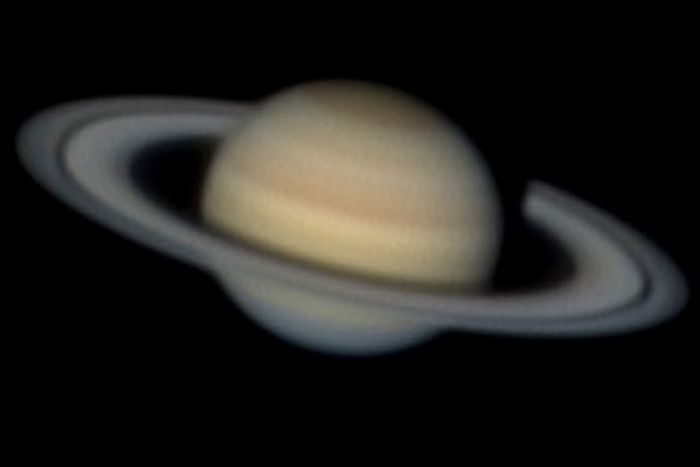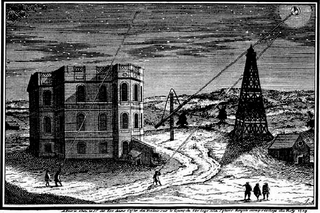Squinting At Saturn Through 17th Century Technology

(ISNS) -- A team of French researchers has shed light on an important moment of astronomical history by testing the old lenses used by astronomer Jean-Dominique Cassini when he observed a minuscule gap between two of Saturn's rings in 1675. Questions have lingered over whether it was possible to see this gap, which was later named the "Cassini Division," with the optics he had at his disposal.
"I don't think I've ever been able to see the Cassini Division clearly with my own backyard telescope," said Laird Close, an astronomer at the University of Arizona's Steward Observatory. The 3000-mile wide gap "is not a trivial thing to see."
At its closest, Saturn is nearly 750 million miles from Earth. At this distance, the Cassini Division has an angular size of 0.65 seconds of arc, or about 3,000 times smaller than the moon, which spans about half a degree of visual angle.
When Galileo first observed the rings of Saturn in 1610, he described them as "ears" because his telescope couldn't resolve the rings as being separate from the planet. Only 65 years later, how was Cassini able to see not only the rings, but also the band between the two most prominent rings? It turns out that a fortuitous set of circumstances – the timing, atmospheric conditions, and high-quality lenses – contributed to the successful observation.
In a letter to the Royal Society in 1676, Cassini described Saturn's ring as being "divided by a dark line."
Saturn's rings are constantly changing their angle, or inclination, with respect to Earth, and Galileo was stumped when, in 1612, they became oriented edge-on and "disappeared."
However, the new study's lead author Julien Lozi said Cassini had an advantage.
Sign up for the Live Science daily newsletter now
Get the world’s most fascinating discoveries delivered straight to your inbox.
"The conditions were almost optimal – the rings were almost at a maximal inclination and the division had a maximal size," said Lozi, an optical scientist at the University of Arizona and NASA Ames Research Center in California.
The altitude and atmosphere of Paris, where Cassini made his observations and his lenses are still kept, were not ideal, but on the plus side, there was no impeding street lighting. Lozi said Cassini's drawings from the time don't show a very clear line, but a difference in color between the two main rings, and something separating them.
Besides the fortunate planetary tilt, well-timed atmospheric fluctuations – the reason planets shimmer and stars twinkle – may have helped tease out the division in the rings, said Close.
But Cassini didn't have to rely on luck alone. The quality of his telescope lenses, fabricated by optician Giuseppe Campani in Rome, was "impressive," according to Lozi.
The biggest problem at the time was shaping and polishing the glass so it would achieve a uniform refractive index – a measure of how strongly incoming light is bent to achieve a focus. Though there were bubbles and scratches in the lenses, Campani apparently was one of the best lensmakers of the time, and guarded his techniques carefully, sharing them with only his daughter. According to Lozi, "it took a long time to understand how he was able to produce such good lenses. It took 100 years just to find his instruments."
The central problem with the lenses, though, was their chromaticity, or the way different wavelengths of light bend unequally when passing through a lens. The view through the eyepiece, said Close, would have "a rainbow halo of light around it, because wavelengths come to focus at different points, but your eyeball can only be in one place at once."
Modern telescopes and binoculars have optical mechanisms to correct for these aberrations – which naturally occur anytime light is bent – but in the 17th century these were not available. The only way to compensate for chromaticity was to use lenses with long focal lengths, meaning the focused image would appear anywhere from seven to 50 meters away from the lens. This meant that the telescopes of the time could become unwieldy. The viewing eyepiece could be at street level, but the lens would be placed atop a building or tower.
"These telescopes were ridiculously, extremely long," said Close. "They were as long as telephone poles but as wide as a coffee cup." And pointing the telescope at Saturn as it moved in the sky would have been a tedious job, done by a team of assistants. One of the telescopes Cassini used was 11 meters (36 feet) long with a 34-foot focal length lens, while other lenses in the arsenal had focal lengths up to 155 feet. The diameters of the lenses exceeded 13.5 centimeters (about 5.3 inches).

At the behest of the Paris Observatory, Lozi and colleagues tested the quality of the lenses, and simulated what the planets would have looked like to Cassini when he used them in his stargazing. Their results were presented at the SPIE Optics+Photonics conference in August, and appear online in a repository for preliminary scientific papers called arXiv. The long focal lengths not only reduce the chromatic effects, but also diminish the impact of the sometimes flawed polishing.
Close, who was not part of the study, was also impressed. "The quality of the lenses was about as good as it could be." In one lens, the Strehl ratio, a measure of optical quality, was 0.94, where 1 is perfect. Even for modern optics, this is an exceptionally good lens, Close said. "Except for the chromaticity these are almost perfect lenses."
Using information about the focusing abilities of the five tested lenses, the researchers produced images of the planets that approximate what Cassini could have seen more than 300 years ago. The gap in Saturn's rings can be seen clearly. "For viewing very bright things like planets, at the time it was the perfect technology," said Close. "But it still would not have been an easy observation." And perhaps this is why there was ever any doubt: seeing the gap in the rings was right on the edge of what was possible at the time.
For Lozi, this side project holds relevance for the modern search for exoplanets, which is his primary area of research. The Cassini Division was the first example of gaps in planetary rings, and astronomers have since found similar disks of dusts around stars, such as TW Hydrae, which is about 176 light years from Earth.
Finding gaps in the disks around stars is especially exciting to astronomers, because they could signal the presence of exoplanets. Cassini's observation of the division in Saturn's rings, and his related theory about the dust surrounding moving planets -- the so-called zodiacal light -- thus continue to influence modern astronomy.
One of the study's simulated views of Saturn through Cassini's lenses. The image appears alternately blurry and clear because of atmospheric turbulence effects.
Inside Science News Service is supported by the American Institute of Physics. Amanda Alvarez has written about science for the Milwaukee Journal Sentinel, Yale Medicine, and GigaOM. She received her PhD in Vision Science from the University of California, Berkeley, and tweets at @sci3a.











